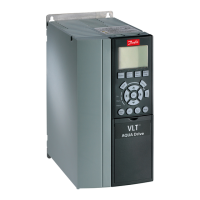7.1.1 Overvoltage Trips
This trip occurs when the DC bus voltage reaches its DC
bus alarm voltage high. Before tripping, the drive shows a
high-voltage warning. Usually, the cause of an overvoltage
condition is fast deceleration ramps relative to the inertia
of the load. During deceleration of the load, inertia of the
system acts to sustain the running speed. Once the motor
frequency drops below the running speed, the load begins
overtaking the motor. The motor becomes a generator and
starts returning energy to the drive. This process is called
regenerative energy. Regen occurs when the speed of the
load is greater than the commanded speed. The diodes in
the IGBT modules rectify this return voltage, which raises
the DC bus. If the amount of returned voltage is too high,
the drive trips.
Ways to avoid overvoltage trips
•
Reduce the deceleration rate. The drive can only
decelerate the load slightly faster than it would
take for the load to naturally coast to a stop.
•
Allow the overvoltage control circuit to take care
of the deceleration ramp. When enabled, the
overvoltage control circuit regulates deceleration
at a rate that maintains the DC bus voltage at a
level that keeps the unit from tripping.
Overvoltage control corrects minor, but not major
discrepancies between ramp rates. For example, if
a deceleration ramp of 100 s is required, and the
ramp rate is set at 70 s, the overvoltage control
corrects it. However, with the same inertia, if the
ramp is set at a larger
dierence, such as 3 s,
overvoltage control engages initially, and then
disengages, allowing the drive to trip. This trip is
done deliberately to avoid confusion about the
operation of the drive.
•
Control regenerated energy with a dynamic
brake. If the DC bus level becomes too high, the
drive switches the resistor across the DC bus. The
unwanted energy is dissipated into the external
resistor bank mounted outside of the drive. This
process increases deceleration rate.
Less often, the load causes an overvoltage condition while
running at speed. When this condition occurs, the dynamic
brake option or the overvoltage control circuit can be
used. For example, if the speed of the load is greater than
the commanded speed, the overvoltage circuit increases
the frequency to match. The same restriction on the
amount of inuence applies.
The drive adds about 10% to the base speed before a trip
occurs. Otherwise, the speed could continue to rise to
potentially unsafe levels.
7.1.2 Mains Phase Loss Trips
Mains phase loss trips in D-sized drives
D-sized drives monitor phase loss by monitoring the
amount of ripple voltage on the DC bus. Ripple voltage on
the DC bus is a product of a phase loss, and can cause
overheating in the DC bus capacitors and DC coil. If the
ripple voltage on the DC bus is unchecked, the lifetime of
the capacitors is reduced signicantly.
When the input voltage becomes unbalanced or a phase
disappears completely, the ripple voltage increases. This
increase causes the drive to trip and issue alarm 4, Mains
Phase Loss. In addition to missing phase voltage, a line
disturbance or imbalance can increase bus ripple.
Mains phase loss trips in E-sized drives
In E-sized drives, mains imbalance is directly measured by
the inrush card. If the voltage imbalance is greater than
10%, then the drive is considered to be in single-phase
mode. Once a predetermined motor power is exceeded,
the drive trips. If communication with the inrush card is
lost, the drive reverts to the phase loss monitoring of the
D-sized drive.
The following parameters show the input voltage:
•
Parameter 18-70 Mains Voltage [0] shows the
average of the 3 input phases.
•
Parameter 18-70 Mains Voltage [1] shows the
voltage between R and S phases.
•
Parameter 18-70 Mains Voltage [2] shows the
voltage between S and T phases.
•
Parameter 18-70 Mains Voltage [3] shows the
voltage between T and U phases.
•
Parameter 18-72 Mains Imbalance measurement of
the mains imbalance.
Possible sources of disturbance
Loads
aecting the form factor of the AC waveform cause
line disturbances. For example, notching or defective
transformers can cause disturbances.
Mains imbalances that exceed 3% cause sucient DC bus
ripple to initiate a trip. In 12-pulse systems, the allowed DC
ripple is smaller than the ripple allowed in 6-pulse systems.
Other causes of increased ripple voltage on the DC bus
include:
•
Output disturbance.
•
Missing or lower than normal output voltage on
1 phase.
Drive and Motor Application... Service Guide
MG94A502 Danfoss A/S © 02/2019 All rights reserved. 81
7 7

